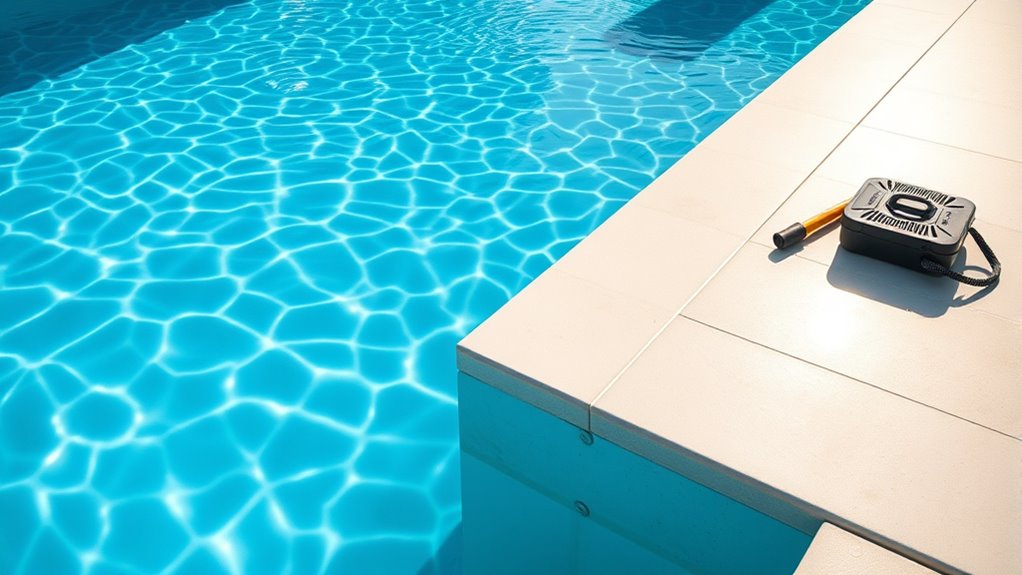If your endless pool faces issues like it not powering on, poor water circulation, error messages, or strange noises, start by checking power sources, circuit breakers, and wiring. Verify filters and jets are clean, and control panel connections are secure. For overheating or leaks, inspect equipment and seals. Unresponsive screens or jets may need resets or cleaning. For persistent problems, seeking professional help is wise. Keep going to discover detailed solutions for each common problem.
Key Takeaways
- Check power sources, circuit breakers, and wiring for electrical issues causing the pool not to turn on.
- Inspect the pump, filter, and impeller for blockages or damage to ensure proper water circulation.
- Verify control panel connections and reset the system to resolve unresponsive display or error messages.
- Ensure water temperature sensors and heating elements are functioning to maintain proper temperature regulation.
- Regularly maintain jets, air pumps, and seals to prevent leaks, noise, and air bubble problems.
The Pool Won’t Power On

If your endless pool won’t power on, the first step is to check the power source. Make sure the outlet is functioning by plugging in another device. Reset any circuit breakers or GFCI outlets that might have tripped. Inspect the power cord for damage or loose connections. If your pool has a dedicated power switch, confirm it’s turned on. Sometimes, a simple power surge or outage can cause the system to shut down. If everything seems fine but the pool still won’t turn on, try unplugging it for a few minutes, then plug it back in. This can reset any internal safety features that might be preventing startup. Always verify safety precautions when handling electrical components to avoid shocks or further damage. Additionally, consulting your home security setup can help ensure there are no external electrical issues affecting your pool.
Water Circulation Is Weak or Nonexistent

When water circulation in your endless pool feels weak or stops altogether, the issue often lies with the pump or its components. Check if the pump is running; if it isn’t, inspect the power supply and circuit breaker. If the pump runs but circulation remains poor, the impeller may be clogged or damaged, reducing flow. Also, ensure the filter isn’t dirty, as debris can block water movement. Here’s a quick overview:
| Issue | Possible Cause | Solution |
|---|---|---|
| No water movement | Pump not running | Reset breaker or replace fuse |
| Weak circulation | Clogged filter | Clean or replace filter |
| No flow or very slow flow | Damaged impeller | Repair or replace pump |
Address these core areas to restore proper water flow quickly. Additionally, understanding the water circulation system can help identify underlying issues more effectively.
Error Messages Appear on the Control Panel

Encountering error messages on your control panel can be frustrating, especially when you’re trying to enjoy your pool. These messages usually indicate a problem with the system that needs attention. First, note down the error code or message displayed. Consult your user manual to understand what it means; common issues include sensor malfunctions or power supply problems. Sometimes, turning off the pool’s power and restarting it can clear temporary glitches. If the error persists, check for loose wiring or faulty sensors, and ensure all connections are secure. In some cases, you may need to reset the control panel or update the software. If you’re unsure or the error continues, contact a professional pool technician for help. Ignoring these messages can lead to further damage or system failure. Additionally, being aware of innovative cloud solutions can help you access remote diagnostics and updates for your pool system.
Unusual Noises During Operation
If your pool makes strange noises during operation, it could be due to worn-out bearings or loose pump components. Debris in the motor can also cause grinding or banging sounds. Identifying these issues early can help prevent more serious damage and keep your pool running smoothly. Regular maintenance, such as checking for proper airflow, can also reduce noise levels and improve performance.
Worn Out Bearings
Worn out bearings often produce unusual noises during pool operation, signaling that maintenance may be needed. You might notice grinding, squealing, or rumbling sounds coming from the pump area. These noises occur because the bearings have become damaged or worn, reducing their ability to support the motor shaft smoothly. If you ignore the signs, the bearings can seize or cause additional damage to the pump. To fix this, shut off the pool and inspect the pump. If bearings are worn, replace them with compatible parts. Regular maintenance and lubrication can extend the lifespan of your bearings, but once symptoms appear, prompt replacement is essential to keep your pool running quietly and efficiently. Enhanced natural language processing can also help in diagnosing issues with pool equipment through advanced monitoring systems. Don’t delay, as neglecting this can lead to costly repairs.
Loose Pump Components
Loose pump components can cause unsettling noises during pool operation, often manifesting as banging, rattling, or vibrating sounds. These noises happen when parts such as impellers, housing screws, or mounting brackets aren’t securely fastened. Vibrations from loose components can also lead to increased wear and potential damage. To fix this, turn off the pool pump and inspect the pump assembly carefully. Tighten any loose screws, bolts, or fittings with the appropriate tools. Check that the impeller is firmly attached and free of debris. If you notice any damaged or worn parts, replace them before restarting the pump. Regularly inspecting and tightening pump components helps prevent noise issues and prolongs your pump’s lifespan. Addressing loose parts promptly ensures smooth, quiet operation. Additionally, consulting equipment maintenance tips can help ensure all components are properly secured and functioning optimally.
Debris in Motor
Debris trapped inside the motor can cause unusual noises during pool operation, such as grinding, squealing, or rattling sounds. When debris like dirt, leaves, or small objects enter the motor, it disrupts the smooth movement of the impeller or fan blades. This interference creates noise and can damage internal parts if left unaddressed. To fix this, turn off the pool and disconnect the power. Remove the motor cover or housing carefully, then inspect for visible debris. Use a brush or compressed air to clear out any particles. After cleaning, reassemble the motor, ensuring all parts are properly secured. Regular maintenance and filter checks help prevent debris buildup, keeping your pool running quietly and efficiently. Proper maintenance practices can further reduce the chances of debris entering the motor and causing issues.
The Water Temperature Isn’t Changing

Have you noticed that your Endless Pool’s water temperature isn’t changing despite adjusting the settings? This can be frustrating, but there are common causes to check first.
- Thermostat Malfunction: The sensor might be faulty, preventing accurate readings.
- Heating Element Issues: The heater could be broken or not receiving power.
- Control Panel Problems: The settings might not be properly communicating with the heater.
Start by inspecting the thermostat for signs of damage and ensure it’s calibrated correctly. Check that the heating element is functioning and receiving power—listen for clicking sounds or look for visible damage. Ultimately, verify the control panel displays the correct temperature and updates when you change settings. Addressing these issues should help restore proper water temperature regulation.
The Treadmill or Resistance System Isn’t Working Properly

If your treadmill or resistance system isn’t working properly, the issue often stems from a faulty motor, worn-out belts, or electrical problems. Check the motor connections first to verify they’re secure and free of corrosion. If the motor runs but the system won’t respond, the motor itself may need replacing. For resistance systems, inspect the belts or cables for signs of wear, fraying, or slack, and tighten or replace as needed. Electrical issues, such as tripped breakers or damaged wiring, can also cause malfunctions. Make sure your system is properly plugged in and that circuit breakers haven’t tripped. Additionally, Kia Tuning options like ECU remapping and performance upgrades can influence electrical system performance and should be checked if all other components are functioning correctly. If these steps don’t resolve the problem, consider consulting a professional technician to diagnose and fix more complex electrical or mechanical faults.
Leaking or Excessive Water Loss

If your pool is losing water faster than it should, start by checking for visible leaks around fittings and hoses. Next, inspect the water level to see if it’s dropping unexpectedly, which can indicate a leak. Finally, confirm all seals are intact and properly maintained to prevent water from escaping. Using a properly functioning pump can also help maintain consistent water levels and prevent unnecessary loss.
Check for Leaks
Start by inspecting your pool regularly for any signs of water loss beyond normal evaporation. If you notice the water level dropping faster than usual, it could indicate a leak. To pinpoint the problem, look for:
- Cracks or visible damage in the pool shell or fittings
- Wet spots or pooling around the pool’s base or equipment area
- Unexplained dampness or mold near the pool components
Pay close attention to connections, seals, and joints, as these are common leak points. Fix any visible damage promptly to prevent further issues. Remember, small leaks can quickly escalate into bigger problems if left unaddressed. Regular checks help catch leaks early, saving you time and money on repairs down the line. Additionally, understanding the material quality of your pool can help identify potential weak spots that may develop into leaks over time.
Inspect Water Level
Are you noticing your pool’s water level dropping more quickly than it should? If so, it’s time to inspect the water level closely. First, check if the water is falling below the recommended level for proper circulation. Constant or rapid water loss can indicate leaks or evaporation issues. Look for wet spots around the pool’s exterior or signs of water pooling near the base. Also, monitor the water level after periods of no use—if it drops substantially, a leak is likely. Keep an eye on the waterline and compare it to the last known level. A consistent drop over time isn’t normal and warrants further investigation to prevent damage and ensure your pool functions correctly.
Maintain Proper Seals
Leaking seals are a common cause of excessive water loss in your endless pool. Over time, seals can wear out, crack, or become loose, leading to leaks. To prevent this, regularly inspect all seals and gaskets around the pool’s lid, skimmer, and plumbing connections. If you notice any damage or gaps, replace or tighten them promptly. Proper sealing not only conserves water but also maintains ideal pool performance.
Key tips include:
- Check for cracks or brittleness in seals regularly
- Replace worn or damaged seals immediately
- Ensure all seals are tightly fitted without over-tightening
Maintaining proper seals keeps your pool efficient and prevents unnecessary water loss, saving you money and hassle in the long run.
The Pool’s Display Screen Is Unresponsive
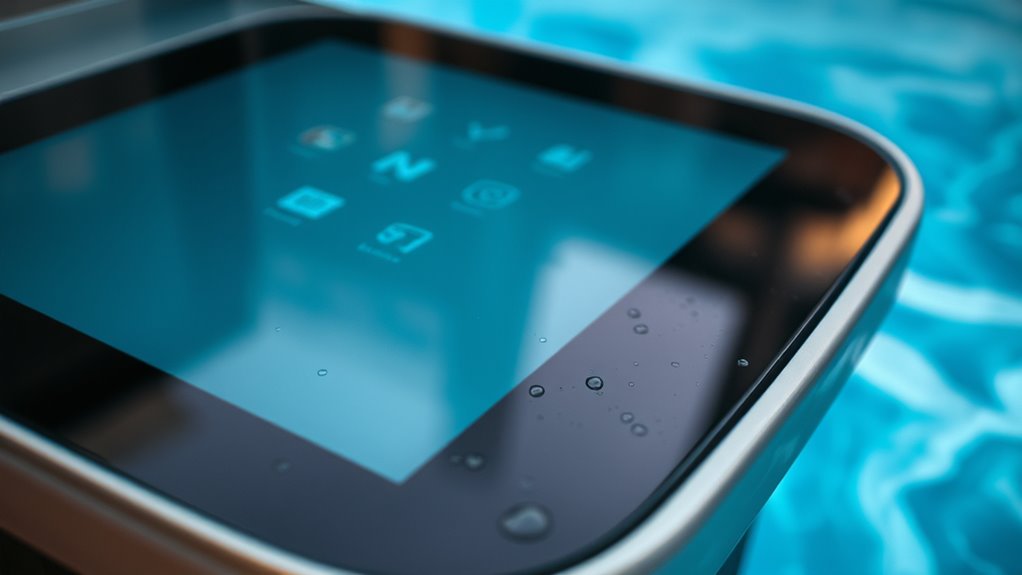
Have you noticed that your pool’s display screen isn’t responding to your taps or commands? This issue can be frustrating, but it’s often caused by simple problems. First, check if the screen is physically damaged or dirty; cleaning the surface gently might resolve the issue. Make sure the pool’s power supply is stable and that the control panel is properly connected. Sometimes, a software glitch can cause unresponsiveness. Try resetting the system by turning off the power, waiting a few minutes, then powering it back on. If the screen remains unresponsive, it could indicate a faulty display or wiring issue. In that case, contacting a professional technician or the manufacturer’s support team is your best bet for a quick fix.
The Pump or Motor Overheats
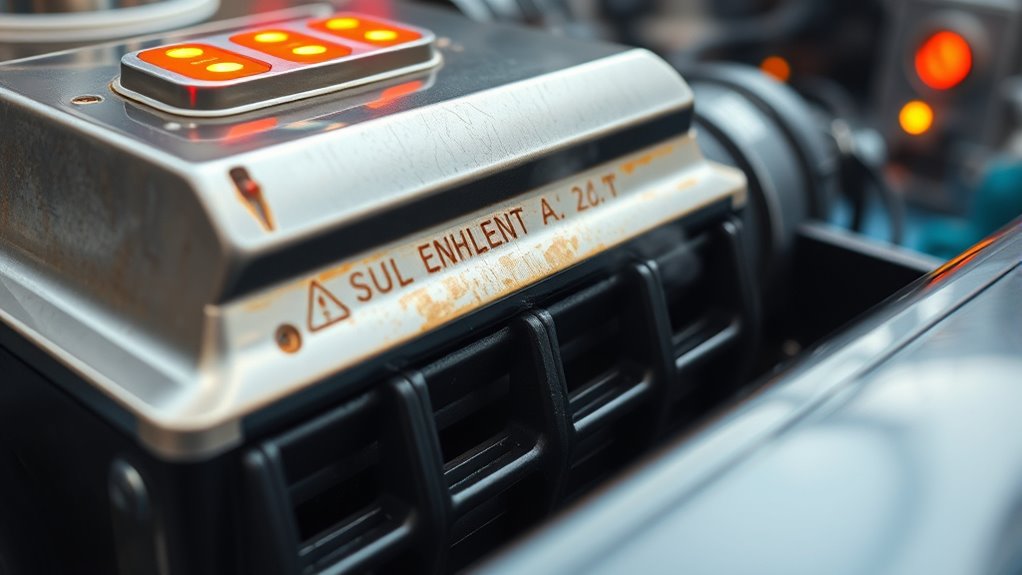
If your pump or motor starts overheating, first check that there’s enough ventilation and space around the unit. Next, inspect the cooling system for blockages or damage, and make certain all electrical connections are secure. Addressing these points can help prevent overheating and keep your pool running smoothly.
Check Ventilation and Space
Proper ventilation and sufficient space around your pool’s pump and motor are crucial to prevent overheating. When these components don’t have proper airflow, heat builds up, increasing the risk of damage. Make certain there’s enough room for air to circulate freely, and avoid placing the pump in enclosed or cramped areas. Regularly check that vents are clear of dust, debris, or obstructions. Proper spacing also helps with maintenance, making it easier to inspect and clean the equipment.
Here are some key tips:
- Keep at least 12 inches of clearance around the pump and motor
- Avoid placing the equipment in enclosed cabinets or tight corners
- Regularly clean vents and fans to maintain airflow
Keeping space and ventilation in check helps your pool run smoothly and prevents overheating issues.
Inspect Cooling System
When your pool’s pump or motor starts to overheat, it’s a clear sign that the cooling system isn’t functioning effectively. Check for blocked vents, debris, or buildup around the motor that could hinder airflow. Confirm the pump’s fan is operating properly and that water flow isn’t restricted. If overheating persists, consider whether the coolant levels are adequate or if parts need replacement. Proper cooling prevents damage and prolongs your equipment’s lifespan.
| Issue | Solution |
|---|---|
| Poor airflow | Clear vents and remove debris |
| Insufficient water flow | Check for clogs or closed valves |
| Faulty fan | Test or replace the fan |
| Low coolant levels | Refill coolant as needed |
| Worn-out parts | Schedule repairs or replacements |
Verify Electrical Connections
Are loose or corroded electrical connections causing your pump or motor to overheat? Faulty wiring can lead to poor electrical flow, increasing resistance and generating excess heat. To fix this, first, turn off the power and inspect all connections. Look for signs of corrosion, loose wires, or burnt terminals. Tighten any loose connections and replace corroded or damaged wires. Ensuring proper contact minimizes resistance and prevents overheating.
Key steps include:
- Checking for corrosion or rust on terminals
- Tightening loose screw or wire connections
- Replacing damaged or worn electrical components
Taking these actions helps improve electrical flow, reduces heat buildup, and extends your pool equipment’s lifespan. Regular inspections prevent future overheating issues and keep your pool running smoothly.
Issues With Air Bubble Generation or Jets

Air bubble generation and jet issues can disrupt your swimming experience by creating unwanted turbulence and noise. If you notice fewer bubbles or uneven jet flow, the problem might be with the air supply or valve settings. Check that the air intake isn’t blocked or clogged, and make sure the air pump is running properly. Sometimes, filters or debris can restrict airflow, so clean or replace them as needed. Also, inspect the jets for mineral buildup or blockages that could hinder water flow. Adjusting the air valves may improve bubble production. If these steps don’t resolve the issue, the air pump or jet mechanism might need professional repair or replacement. Addressing these problems promptly ensures a smoother, quieter swim with consistent bubble activity.
Frequently Asked Questions
How Often Should I Perform Maintenance on My Endless Pool?
You should perform regular maintenance on your endless pool every 1 to 3 months. This includes checking and cleaning the filter, inspecting the pump and heater, and balancing the water chemistry. Also, regularly skim debris and test water levels to guarantee everything runs smoothly. Consistent upkeep helps prevent problems, keeps your pool clean, and extends its lifespan. Stay vigilant and follow the manufacturer’s recommendations for peak performance.
Can I Use My Pool During Power Outages?
Think of your pool as a steady heartbeat; during power outages, it temporarily pauses, but your connection remains. You can use your pool during outages if it has a backup power source or manual controls, but without power, the circulation and filtration stop, risking water quality. To keep swimming safe, consider installing a generator or planning use during known outages. Your pool’s resilience depends on how well you prepare for these silent pauses.
What Safety Precautions Should I Follow With the Control Panel?
You should always keep the control panel dry and avoid splashes that could cause electrical shorts. Before adjusting settings, make sure the power is off to prevent accidental shocks. Use the panel in a well-lit area so you can clearly see the controls, and never tamper with internal components. Regularly inspect the wiring for damage and follow the manufacturer’s safety instructions to prevent accidents and ensure safe operation.
Is It Normal for the Water to Have a Slight Odor?
Yes, it’s totally normal for your pool water to have a slight odor, like a whisper of a scent, not a foul stench. This tiny smell is usually caused by natural bacteria or minerals reacting with the water. To keep it fresh, make sure you’re regularly balancing your pool’s pH and chlorine levels. Proper maintenance prevents the odor from turning into something you’d swear could wake the dead!
How Do I Reset My Pool’s Error Codes?
To reset your pool’s error codes, turn off the power supply to the pool’s control system. Wait for about 30 seconds, then turn it back on. If your pool has a reset button, press and hold it for a few seconds. Alternatively, consult your user manual for specific reset instructions, as procedures can vary by model. This should clear the error codes and restore normal operation.
Conclusion
If you ignore these endless pool problems, your backyard oasis could turn into a swamp faster than you can say “drain and refill.” Don’t let minor glitches turn into costly disasters or turn your relaxing swim into a frustrating nightmare. With quick fixes and regular maintenance, you can keep your pool running smoothly and your summer stress-free. Stay vigilant, troubleshoot early, and keep your endless pool the paradise it’s meant to be!
